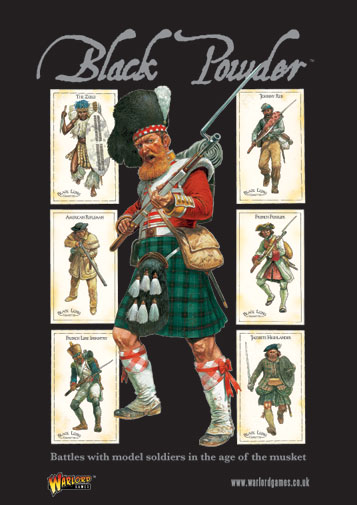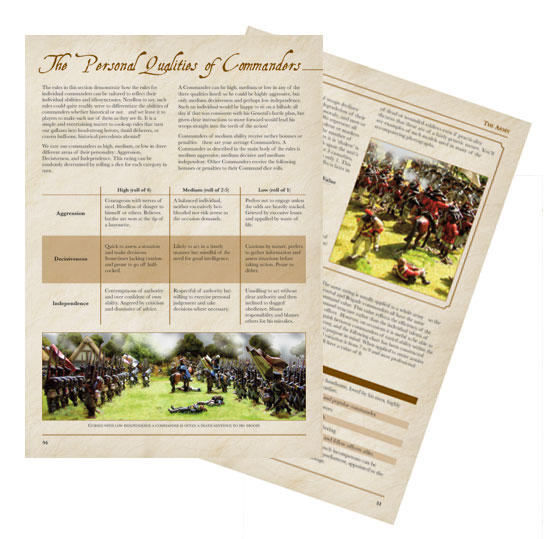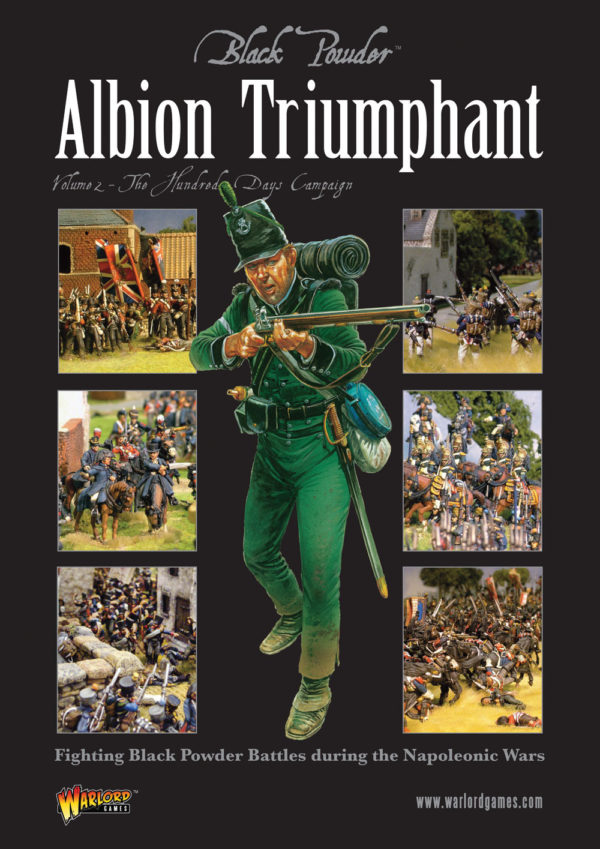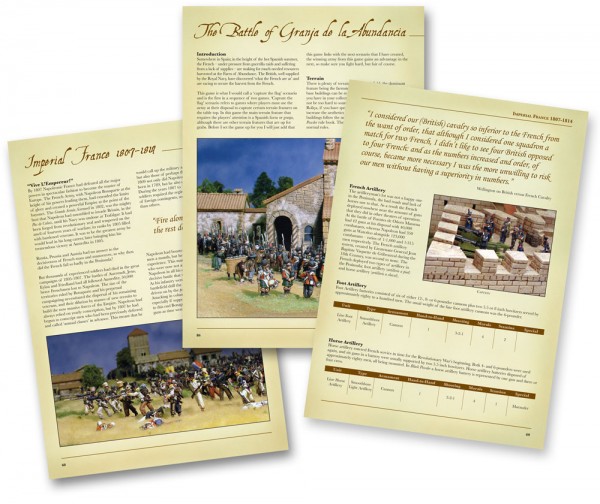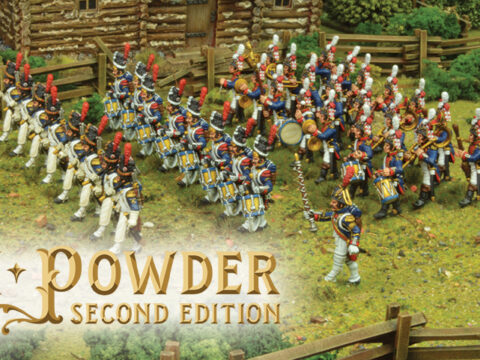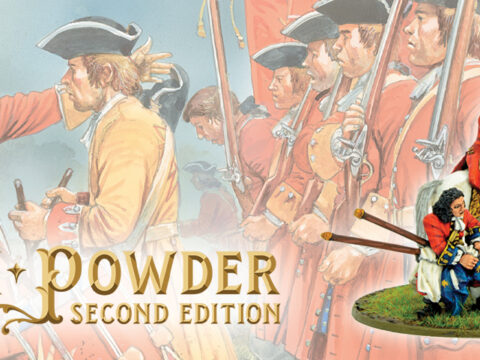The Road to Waterloo: From Both Sides of the Atlantic
By Les Mansir and Richard Caldwell
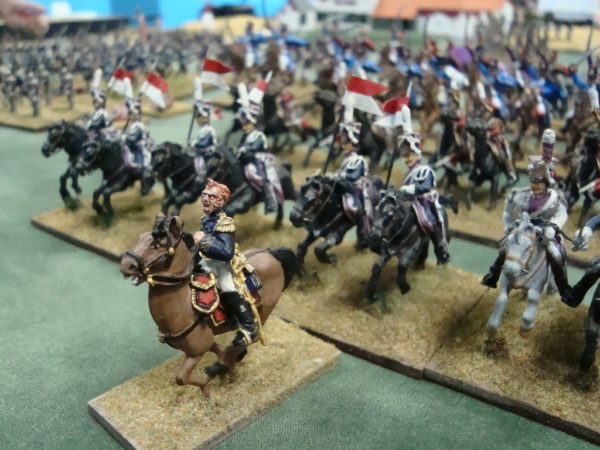
“Years later, the surviving French and British soldiers who faced off at the walled farm of La Haye Sainte will call it….”La Hell Sainte”
La Haye Sainte was in the middle of the battlefield at Waterloo – Wellington prepared for the French attack by organising his forces into a series of layers;
– Several companies of the Kings German Legion occupying the walled farmstead and orchard located just outside the walls.
– Further back were successive lines of skirmishers pulled away from their parent regiments.
– The third line of defence rested on a long ridge that ran across the width of the La Haye Sainte battlefield – comprised of two batteries of artillery, a Congreve Rocket battery and a Battalion of Belgians.
– The final and strongest line lay just behind that ridge where the full sized battalions of the English waited.
A stillness lay over the battlefield, broken only by the cries of the Motley bird…when a movement through the cornfields leading up to and around the farmstead were noted…soon, the gold imperial eagle standards and French Tricolours could be seen sticking up above the corn stalks…..
French infantry (and plenty of them!) were moving up in assault columns…Wellington was awoken from his nap underneath the elm tree…he sat up and looked out of the field down below….”ahh…right then…it looks like the game is afoot”
And this started the day long 7 turn battle for La Haye Sainte.
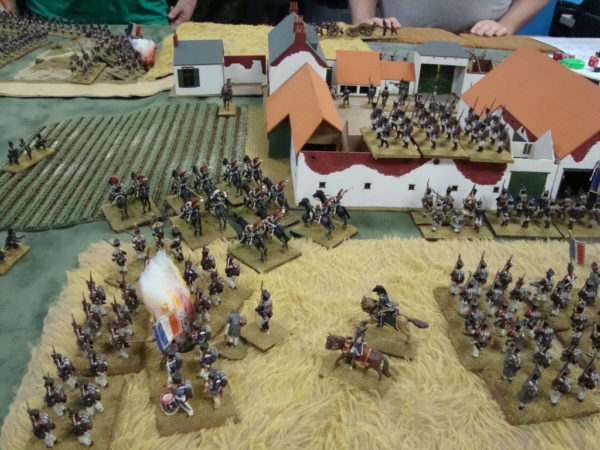
When Les Mansir and Richard Caldwell decided to collaborate to create a game commemorating the 200th anniversary of the battle of Waterloo – and offered to share photographs and a write-up of the game, the only possible answer was: “Heck yes!”
Over to Les and Rich…
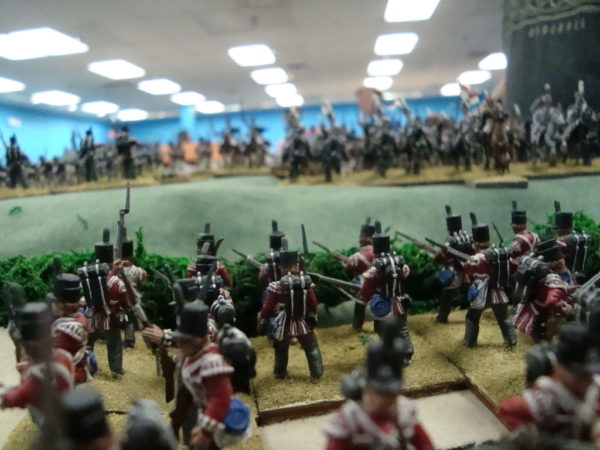
We have had a great time setting up this game, play testing rules and forces. None of this has been particularly new to either of us. We are old, veteran war gamers. Each has over 40 years as miniature war gamers. However, our roads to the Waterloo game have been somewhat different!
(Richard is Scottish and Les is a Texan!) We have reached this point in history from both sides of the Atlantic. It has been an interesting journey for both of us.
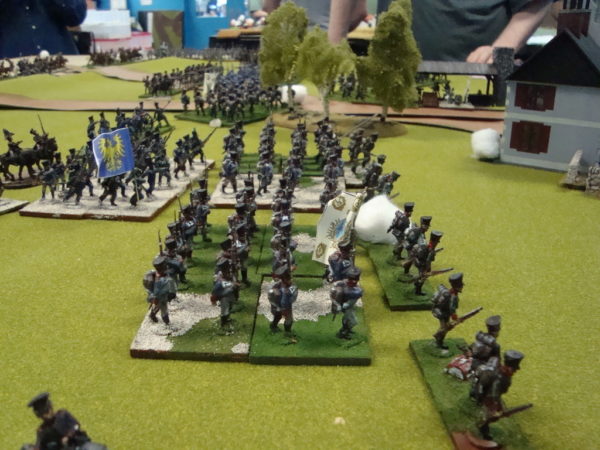
War Gaming Texas-Style
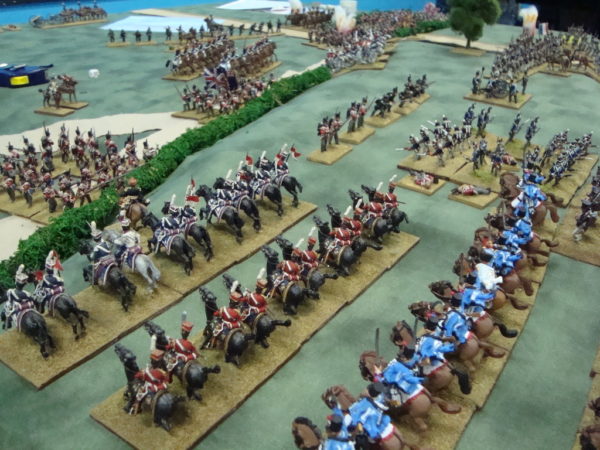
Perhaps it is not so surprising that Les always considered miniature war gaming as a phenomenon from the United Kingdom because when he began gaming in Houston, Texas, in 1964 the books, rules, and miniatures came from the UK. After all, H.G. Wells began the whole thing with his monumental “Little Wars.” Warlord Games and their “Black Powder” system are in the UK! Of course, over the last twenty years the United States, and recently Italy, Spain, Poland and across Europe, the industry has grown massively when it comes to the production and support of miniature war gaming.
Les illustrates the UK influence; For years he spelled many words with the English and not the American spelling. This happened because most of the books that he read were written by UK historians, or gamers and were published in the UK. So, his American English was “contaminated” by English – English. For example, he used the English spelling of armour not the American armor. It wasn’t until he started college that he realized that he had developed this “English” spelling habit. Of course, this was not a problem for Richard, he was living in the UK, and armour was the correct spelling!
Variations in spelling was not the only difference in our gaming in the US in the UK. There were practical problems for gaming in Houston. Les became interested in figure conversion. The old Airfix magazine provided examples of marvellous conversions as well as instructions and techniques. However, the medium suggested to use for filler and adding features was Milliput. What was Milliput? He went to hobby stores and hardware stores looking for this mysterious stuff. No one knew what Milliput was. That was because, at that time, it wasn’t sold in the United States!
Major purchases of miniatures would have to wait until after college. Not having a group to game with was also a definite disadvantage – there were few war game groups in the US in the 1960’s.
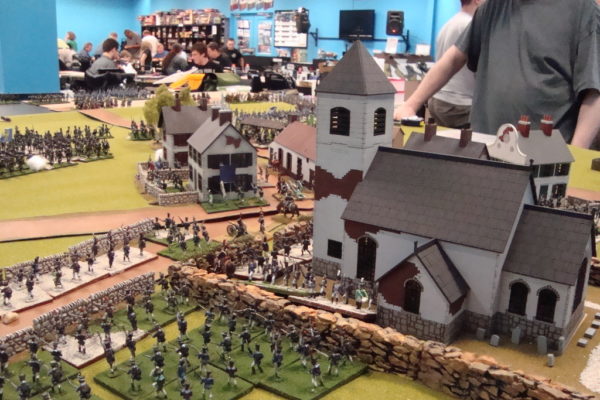
Enter Black Powder!
Black Powder combines tactical and grand tactical aspects of Napoleonic rules in a system that allows games of any size and number of troops. As we are demonstrating in our Waterloo game, a few gamers can put on large scale games, with masses of figures and still be able to finish the game in one day, not one weekend! 2100+ figures, being “pushed” by about 12 gamers in a seven-hour time frame.
In 1970, the movie “Waterloo” provided Les with a Napoleonic gaming opportunity of a lifetime. A Royal Canadian Air Force squadron came to Houston as part of the promotion for the movie. It seems that the squadron had a hobby. They played the Battle of Waterloo in miniature not only for their own entertainment, but also as demonstration game! They didn’t do anything by “halves!” They had all three armies composed of 20 mm miniatures in a 1:20 scale. They had a 40 foot by 20 foot model of the Waterloo battlefield. When the movie came to Houston, the squadron took over the second floor of Joske’s Department store in downtown Houston with numerous displays – and the battlefield.
Les had the privilege of taking command of the Anglo-Allied forces as the great Duke of Wellington! Wow, that would be hard to top. Some details of the battle changed in our game. For example Hougoumont, finally fell by the end of the day as did the Papelotte. But, in both cases, the French were stopped cold by resilient Anglo-Allied troops before the exhausted and spent French could exploit their victories. The day ended with the Prussian army pouring onto the right flank of the terribly battered French.
It was over, the Duke of Wellington – Les – won the Battle of Waterloo once again!
So, there is Les, 40+ years later, and once again, he is going to be refighting the Battle of Waterloo. Only, this time it is not to herald a movie, but to honour and commemorate the officers and men of the armies that fought this climactic battle 200 years ago! Les won’t be the Duke of Wellington. This time, he is going to be leading Prussians in the guise of General von Pirch at the head of the Prussian 2nd Corps.
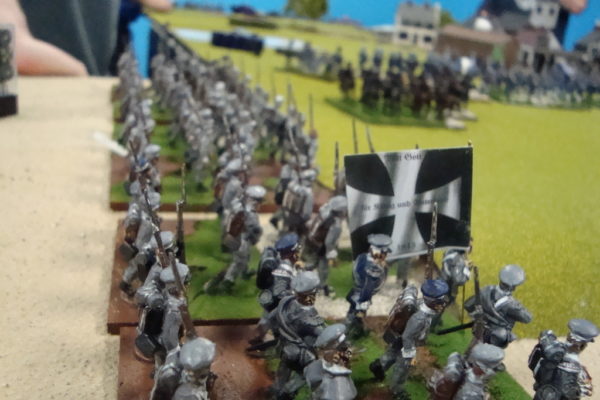
Wargaming from the British perspective
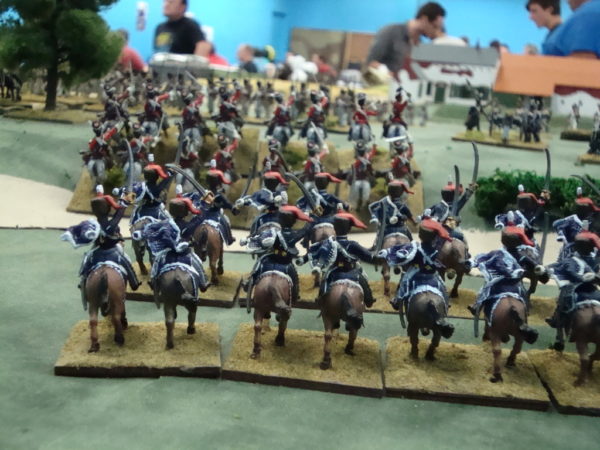
Richard has been an avid Napoleonic wargamer for over forty years now. Ever since he saw the movie Waterloo in London in 1970, he has been inexorably drawn to the glorious uniforms of the period. His first endeavours in miniatures were using Airfix 20mm figures. It was easy to amass sizeable armies relatively cheaply but it was a labour of love to paint them. The soft plastic did not care for the rough and tumble of the battlefield as paint would flake off over time.
Over the intervening years, Richard added figures from Hinchliffe and Minifigs. With the advent of 28mm figures, the marvellous sculpts made it too hard to resist rebuilding his armies to the new scale. Without too much ceremony, the Airfix plastics were “retired” from service after some forty years. Naturally, one must strive with great vim and vigour to replenish the ranks with new recruits! Thus he embarked on rebuilding to divisional strength his British and French forces.
Richard also collected several pieces from convention flea markets along the way including French artillery, some light cavalry and one sad British line infantry battalion. We could tell at once that these stalwart chaps were in distress. Their King’s Colour was attached inverted to the flag pole! Once their flag was properly reattached, the troops were reformed in ranks suitable for Black Powder gaming rules. Richard then went on to convert French Hussars to British Hussars before Warlord came out with their version!
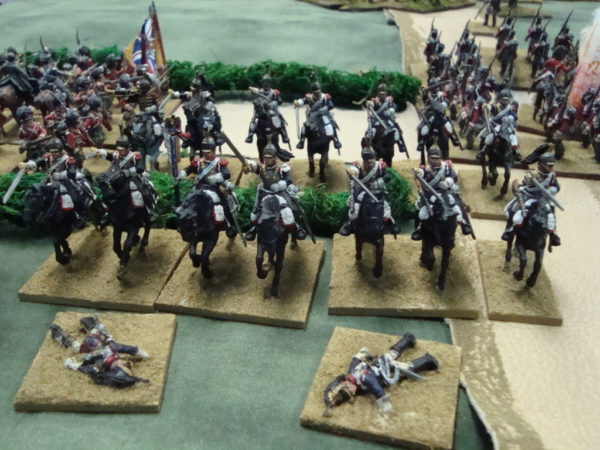
Richard wanted to get back to 9 battalions of British Line with artillery and at least one regiment of light cavalry and one of heavy. The heavy cavalry were 25mm Scots Greys. The lights were the 10th Hussars converted from their French counterparts. He could not bear to part with the Greys after so many years. He already had French heavy cavalry in the form of Carabineers resplendent in their gleaming copper cuirasses.
Richard then set about building French line battalions. Three battalions in total – 108 figures fully decked out. But to his horror, on the wrong size bases! Cutting plastic figures off a base is not for the faint of heart. With the aid of a powered fret saw, he cut the bases to release two figures at a time. Painstaking work to avoid losing limbs on overlapping minis as well as risking fingertips to the saw blade! Happily all figures and fingers survived the ordeal with the exception of a drummers arm and drum which were quickly reattached. Les meanwhile was starting from scratch and had to do a lot of work to catch up!
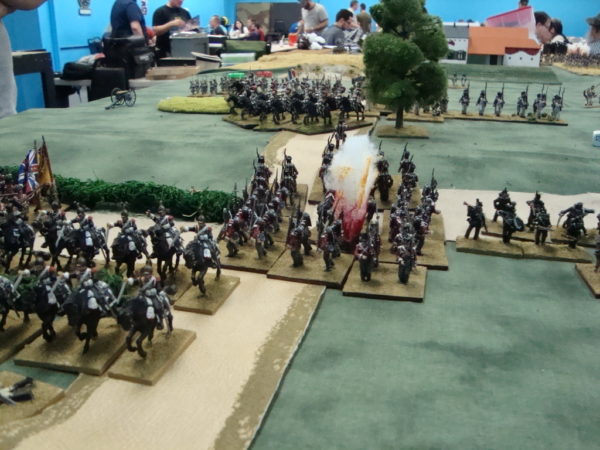
Inspiration
The original inspiration to celebrate Waterloo was the upcoming 200th anniversary on June 18th 2015. A mere 6 months away. Richard did have the good fortune in 1981 to visit Waterloo battlefield on a cold rainy March day. He was taken by several discoveries. The first was how small the battlefield was, Secondly how gloomy it felt and lastly by the fact that no birds were to be seen or heard. The same gloominess pervades Glencoe in Scotland.
Anyway, eerie feelings aside, he thought that we could create a fun event for our “like minded enthusiasts” of the Central Maryland Wargamers Group, alas minus the “good brandy and fine cigars.” Copious quantities of pizza and soft drinks would have to suffice.
With the advent of the La Haye Sainte farm collector’s set in 28mm, we could have the Black Powder event centre on the struggle for the farm. To that end we would need sufficient troops to create a fair sized action around the farm.
Les thought that including Plancenoit would add an interesting aspect to the game since most battles focus on the Allied/French struggle. However, after looking at the battlefield we would need to add a right angled section to Richard’s existing table. Regrettably there was no room for such an addition. The Prussians could still enter the fray late in the day coming into action on the French flank after a predetermined number of moves. This would put pressure on the French players to capture the farm and breech the Allied line.
His loving wife Judy, gave Richard the La Haye Sainte Collector’s set for the holidays. Once he realised how big the farm buildings were in terms of ground area, the size of the table available he had at home to support the battle began to shrink in size. Both of us have the luxury of a dedicated wargame space with a permanent 4 x 12 foot table in Richard’s case and 5 x 9 in Les’ home. They are raised tables so we don’t need to stoop down to move figures on it which greatly reduces back strain. However the addition of a croupier’s hook or the like would be needed to manoeuvre troops close to the centre of the table. Lacking such a device, the easier solution was to invite a player with very long arms!
With La Haye Sainte at about 18 inches square, four feet of width was not going to be enough to create the right visual impression. We needed to figure out a way to add at least a foot on each side to give sufficient space for the reverse slope behind La Haye on the Allied side and at least the position of the French grand battery opposing it. Four feet wouldn’t do but six would at a pinch.
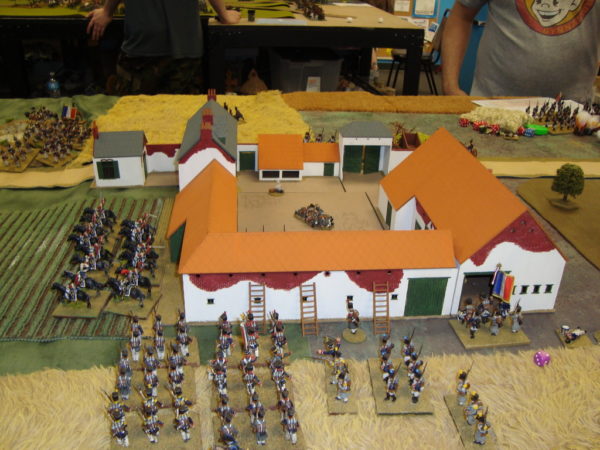
We wanted a flowing battlefield with smooth slopes instead of contoured ones, visually it’s more pleasing and the troops stay in place. We decided to make the slopes shallow to avoid creating too deep a valley in the centre of the field. Using ceiling tiles, we used a foam underpad from a carpet to create a smooth slope for buildings and scenics.
Ultimately we decided that we had to go to a location whose tables could support the battle. Patrick Weaver of Games and Stuff in Glen Burnie, Maryland where the Central Maryland Wargamers meet regularly, agreed to host the event. Thus the space issue was solved. We then expanded the game to include the Hougoumont and Plancenoit scenarios from Albion Triumphant volume 2 and the largest of the scenarios from the La Haye Sainte box set. Now we had a very large three battle game to plan. We ordered up the chateau and several buildings for Plancenoit.
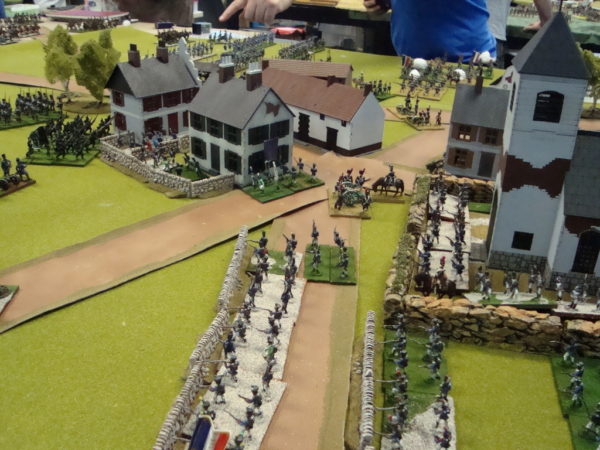
Clearly, we could not replicate the area of the battle precisely. We have limited our troop collections to representative forces for each side at approximately a division of infantry plus supporting light and heavy cavalry and a proportionate number of guns. Once we had the Orders of Battle finalized for the three tables, there would be over 2100 figures on the table so there would be enough eye candy to satisfy the feel of a really big Black Powder game. We love that rule set. It allows spectacular games with lavish numbers of troops on the field with large numbers of figures representing battalions instead of a scant few. With Black Powder you really get the feel of a grand tactical battle.
The expansion of the overall size now raised the next stumbling block in the event planning. How to paint the remaining balance of the 1100 troops in the remaining six months while Les had some 700 of his own to prepare….. To be continued
Richard and Les continue on to battle next week

